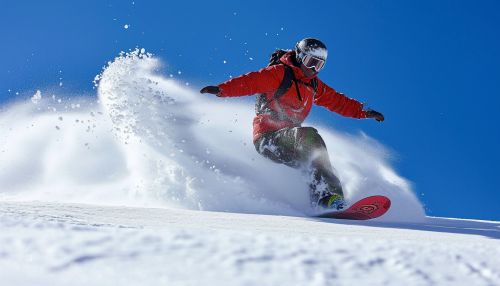Snowboarding
History of Snowboarding
Snowboarding is a winter sport that involves descending a slope covered in snow while standing on a snowboard, a flat board with bindings to secure the rider's feet. The sport was inspired by surfing, skiing, and skateboarding. It was developed in the United States in the 1960s and 1970s and became a Winter Olympic Sport in 1998.


The invention of snowboarding is credited to Sherman Poppen, an engineer from Michigan. In 1965, he built a toy for his daughters by fastening two skis together and attaching a rope to one end. He named it 'Snurfer' (a combination of 'snow' and 'surfer') and it became a commercial success. Over the next decade, various pioneers contributed to the development of the modern snowboard. Notably, Dimitrije Milovich, an east coast surfer, started to develop snowboards following the mechanics of sliding on cafeteria trays during his college years in the early 1970s. His snowboards, known as the 'Winterstick', attracted media attention and were some of the first widely available snowboards.
Equipment and Styles
The basic equipment needed for snowboarding includes a snowboard, bindings, and snowboarding boots. The design and construction of these elements have evolved significantly since the sport's inception, with many different styles of each now available, each suited to a particular type of snowboarding.
Snowboards are generally constructed of a hardwood core which is sandwiched between multiple layers of fibreglass. Some snowboards incorporate the use of more exotic materials such as carbon fiber, Kevlar, aluminium (as a honeycomb core structure), and have incorporated piezoelectric elements.
Bindings are separate components from the snowboard and are very much a matter of personal preference. Snowboard bindings, unlike ski bindings, do not automatically release upon impact or after falling over. With skis, this mechanism is designed to protect from injuries (particularly to the knee) caused by skis twisting when the momentum of the body continues after a fall.
Snowboarding boots are mostly considered soft boots, though alpine snowboarding uses a harder boot similar to a ski boot. A boot's primary function is to transfer the rider's energy into the board, protect the rider with support, and keep the rider's feet warm. A snowboarder shopping for boots is usually looking for a good fit, flex, and looks. Boots can have different features such as lacing styles, heat molding liners, and gel padding that the snowboarder also might be looking for.
There are various styles of snowboarding, each with its own specialized equipment and technique. The most common styles are freeride, freestyle, and alpine snowboarding. Freeride snowboarding is focused on the untracked backcountry and has little to do with tricks and more with riding the best line down the mountain. Freestyle snowboarding is any riding that includes performing tricks. In freestyle, the rider utilizes natural and man-made features such as rails, jumps, boxes, and innumerable others to perform tricks. Alpine snowboarding consists of a small portion of the overall snowboard population, that has a well connected social community and its own specific board manufacturers. Alpine Snowboard equipment includes a ski-like hardshell boot and plate binding system with a true directional snowboard that is stiffer and narrower to manage linking turns with greater forces and speed.
Snowboarding Techniques
Snowboarding techniques vary greatly depending on the type of snowboarding being done. In general, snowboarding involves a combination of carving, jumping, sliding, and even flipping. The rider's leading hand corresponds to their leading foot, i.e., a rider who leads with their left foot is called a 'regular' rider while a rider who leads with their right foot is called 'goofy'.
Carving on a snowboard is like riding a roller coaster, because the board will take the rider in whatever direction it is pointed. When a rider is able to coordinate their movements to effectively ride in this manner, they will experience a smoother, more controlled ride.
Jumping is a critical skill for freestyle snowboarding. It involves the rider springing off the snow with their legs and using their body to propel themselves into the air. While in the air, riders can perform a variety of tricks such as grabs, spins, and flips.
Sliding is another important technique in snowboarding. It involves the rider sliding their snowboard's base flat along the surface of the snow. Sliding is used in a variety of situations, including in tricks and while navigating flat terrain.
Flipping is an advanced snowboarding technique that involves the rider flipping their body and snowboard over in mid-air. This is typically done off of jumps or other features found in the terrain park.
Safety and Training
Like any sport, snowboarding comes with a risk of injury. Most injuries occur during falls; the most common injuries are to the wrist, head, face, and shoulder, with occasional injuries to the back and the chest. To mitigate these risks, snowboarders are advised to use protective gear including helmets, padding for the spine and hips, and wrist and knee braces.
Training for snowboarding is available and recommended for beginners. It typically involves learning basic skills such as turning, stopping, and falling safely, as well as more advanced techniques for experienced riders. Training can be found through snowboarding schools, classes, and private lessons.
Competitions and Organizations
Snowboarding competitions take place around the world and are judged based on a variety of factors including technique, style, and difficulty of tricks. The most prestigious competitions include the Winter X Games, the U.S. Open Snowboarding Championships, and the Winter Olympics.
Several organizations govern the sport of snowboarding and organize competitions, including the International Snowboarding Federation (ISF), the World Snowboard Tour (WST), and the International Ski Federation (FIS). These organizations also set standards for snowboarding equipment and safety.
